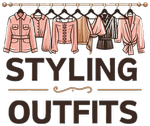The 1960s was a decade of profound change, not just in politics and culture, but also in fashion. From the conservative early years to the psychedelic late 60s, this era saw a dramatic transformation in clothing styles, reflecting the evolving attitudes and values of society. Let’s take a colorful, nostalgic journey through 60s fashion, exploring its iconic trends, influential designers, and lasting impact.
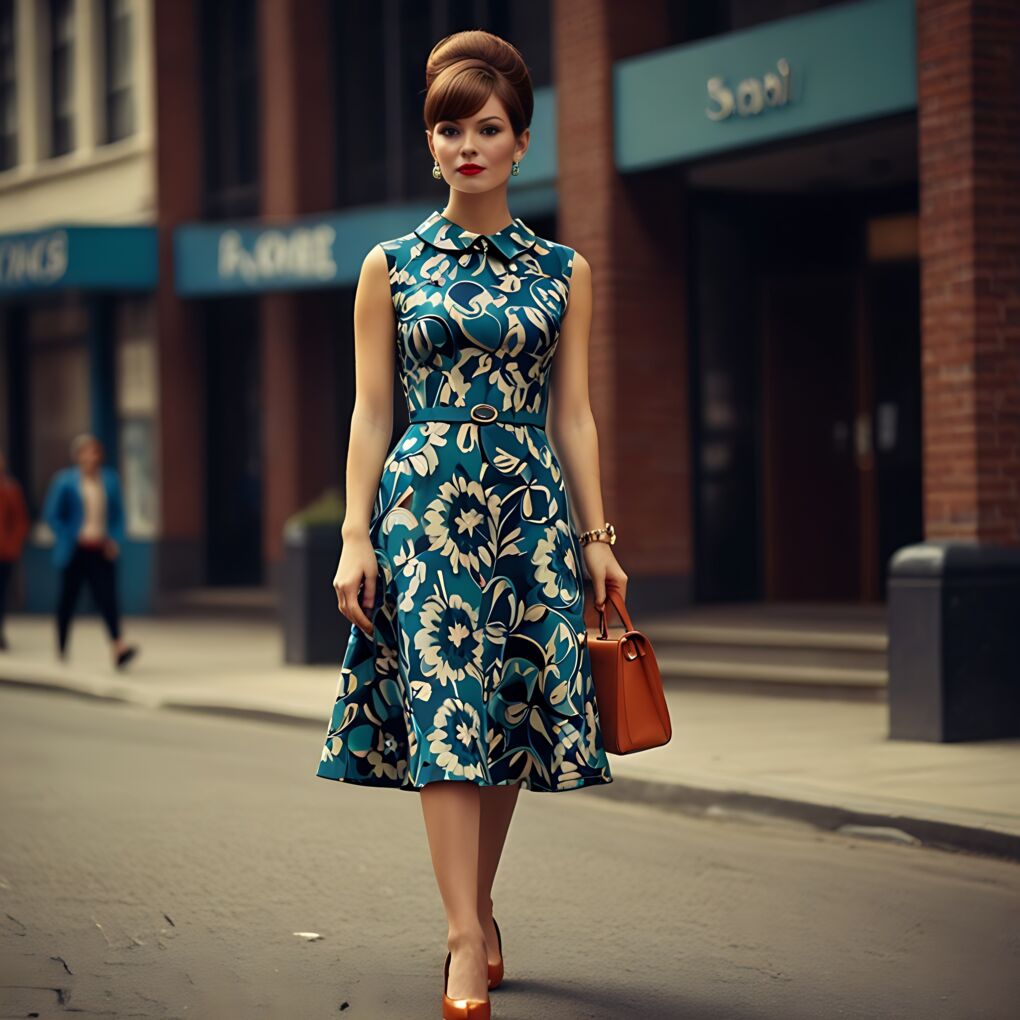
The Early 60s: Elegance and Sophistication
The early 1960s fashion was heavily influenced by the polished, ladylike styles of the 1950s. Women’s fashion, in particular, was characterized by elegance and sophistication, inspired by style icons like Jackie Kennedy and Audrey Hepburn.
Key Fashion Elements:
- A-line skirts and dresses
- Pillbox hats
- Short, boxy jackets
- High heels and pointed-toe shoes
- Pearls and gloves
- Sheath dresses
- Capri pants
- Oversized sunglasses
Designer Coco Chanel continued to be influential, with her classic tweed suits and Little Black Dress remaining staples in many wardrobes. Hubert de Givenchy, famous for dressing Audrey Hepburn in “Breakfast at Tiffany’s” (1961), also shaped the refined aesthetic of this period.
“Fashions fade, style is eternal.” – Yves Saint Laurent
Men’s fashion in the early 60s was similarly conservative. The “Ivy League” look was popular, featuring button-down shirts, slim ties, and tailored suits. Brooks Brothers and J. Press were the go-to brands for this preppy style.
Commercial Products:
- Chanel No. 5 Perfume – The iconic scent that complemented the elegant style.
- Revlon’s “Fire and Ice” Lipstick – A bold red that added a pop of color.
- Maidenform’s “Sweet Dreams” Collection – Structured undergarments for the perfect silhouette.
- Polaroid Sunglasses – Oversized frames favored by stars like Audrey Hepburn.
Pro Tip: When recreating early 60s looks, focus on structure and silhouette. A well-fitted sheath dress or an A-line skirt paired with a boxy jacket captures the essence of this elegant era.
Mid-60s: The Rise of Youth Culture
As the decade progressed, fashion began to reflect the growing influence of youth culture. The post-war baby boomers were now teenagers, and they wanted styles that were distinctly different from their parents’.
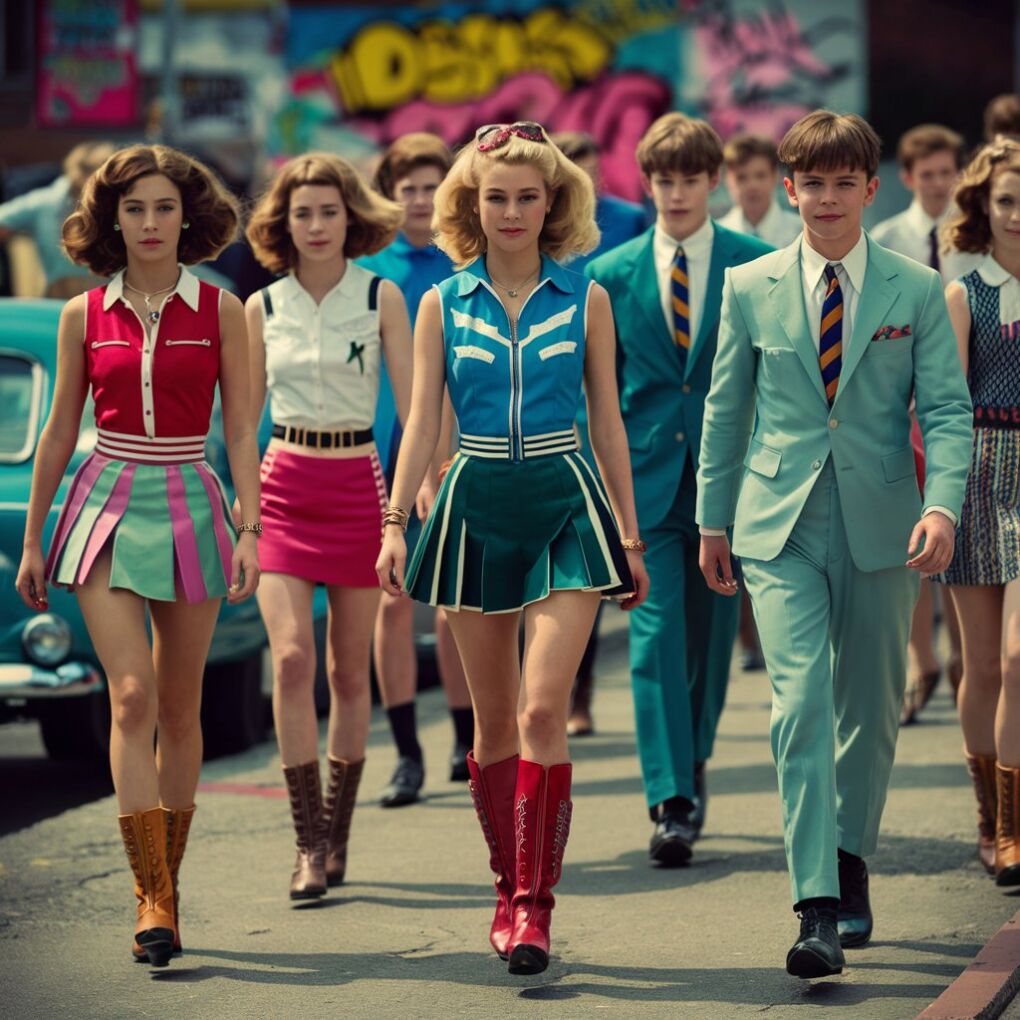
The British Invasion
The Beatles and Rolling Stones didn’t just revolutionize music; they also had a massive impact on fashion. Their mop-top haircuts, collarless suits, and Chelsea boots became must-have items for young men worldwide.
In London, designer Mary Quant was leading a fashion revolution. She is often credited with inventing the miniskirt, which became an iconic symbol of the 60s. Her boutique, Bazaar on King’s Road, was the epicenter of “Swinging London” fashion.
“The miniskirt was a way of rebelling.” – Mary Quant
Iconic British Brands:
- Biba – Barbara Hulanicki’s boutique, known for its art nouveau style and mail-order fashion.
- Granny Takes a Trip – Psychedelic boutique favored by rock stars.
- John Stephen – The “King of Carnaby Street,” his men’s wear defined mod fashion.
- Ossie Clark – Known for his bias-cut chiffon dresses with Art Nouveau prints.
American Response: Mod and Pop Art
Across the Atlantic, American designers were also embracing youthful styles. The “Mod” look, characterized by bold geometric patterns and monochromatic color schemes, gained popularity. Designers like Rudi Gernreich created avant-garde pieces that challenged traditional fashion norms.
Pop Art, with its bright colors and playful imagery, heavily influenced 60s fashion. Artist Andy Warhol’s Campbell’s soup cans and Brillo boxes inspired dresses and shifts, while designer Yves Saint Laurent’s Mondrian dress, based on the artist’s grid paintings, became a sensation.
American Mod and Pop Icons:
- Betsey Johnson – Her Paraphernalia boutique was a mod haven in NYC.
- The Paper Dress – Mars Manufacturing’s disposable dresses, often featuring pop art designs.
- Campbell’s Soup Dress – Created by The Souper Dress company, inspired by Warhol.
- Gernreich’s Monokini – The topless swimsuit that shocked America.
Pro Tip: For a mod look, focus on geometric shapes and bold contrasts. Try a black and white shift dress with oversized polka dots, paired with white go-go boots and large hoop earrings.
Late 60s: Hippie Chic and Futuristic Fashion
The latter part of the 60s saw fashion diverge into two distinct paths: the earthy, free-spirited hippie style and the sleek, futuristic Space Age look.
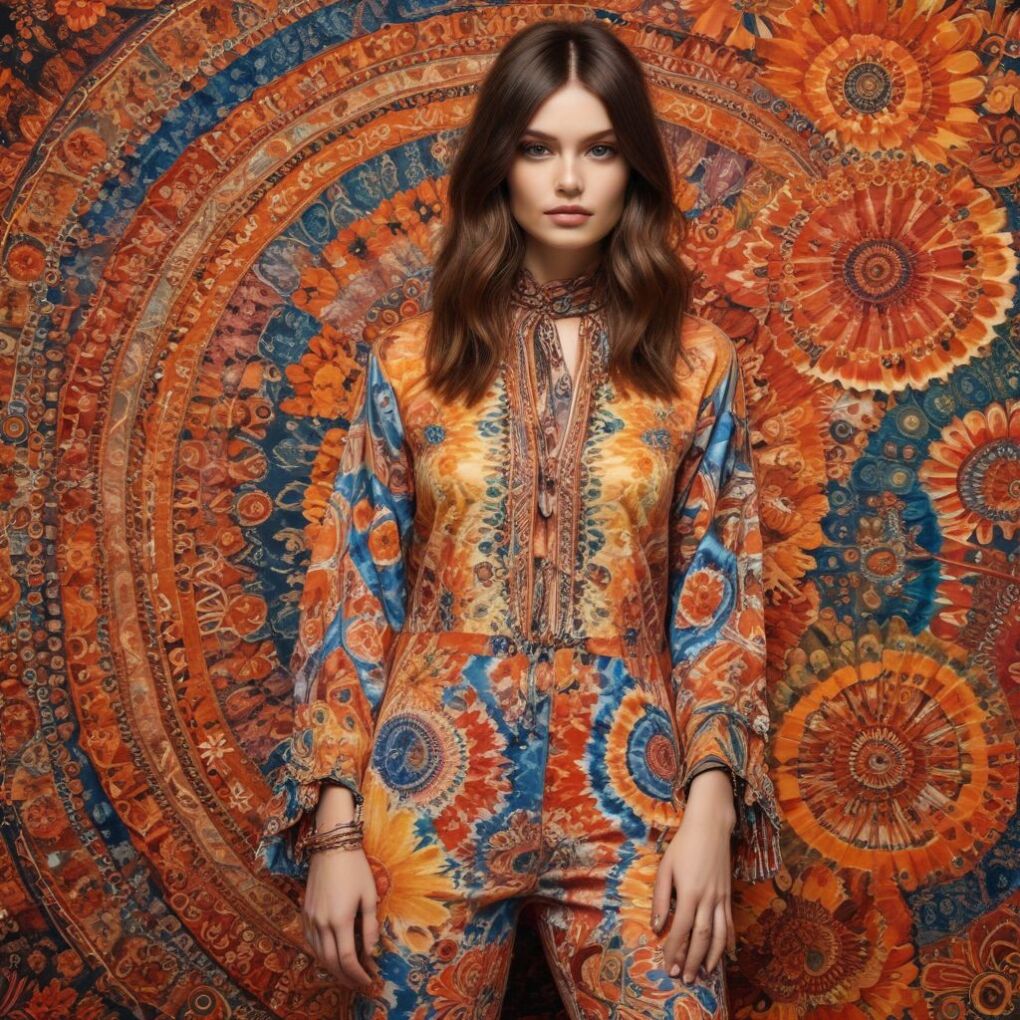
Hippie Fashion
The counterculture movement of the late 60s embraced a more natural, handcrafted aesthetic. Key elements of hippie fashion included:
- Bell-bottom jeans (Levi’s 684 was a popular style)
- Tie-dye shirts
- Fringe vests
- Peasant blouses
- Flower crowns
- Birkenstocks or barefoot sandals
- Dashikis – West African-inspired tunics
- Patchwork anything – jeans, dresses, bags
This style was about rejecting mainstream fashion and embracing individuality. Many hippies made their own clothes or shopped at thrift stores. The 1969 Woodstock festival was a showcase of this laid-back, bohemian style.
Hippie Fashion Brands:
- Birkenstock – The ultimate hippie footwear.
- Mr. Freedom – Tommy Roberts’ London boutique, known for its playful, folksy designs.
- Happi Jacket – Japanese-inspired casual wear.
- I. Magnin – High-end store that embraced bohemian luxe.
Space Age Fashion
In stark contrast to hippie fashion, some designers were looking to the future for inspiration. The Space Race and the moon landing in 1969 sparked a fascination with all things futuristic.
André Courrèges, Pierre Cardin, and Paco Rabanne were the pioneers of this trend. They used unconventional materials like plastic, metal, and PVC to create garments that looked straight out of a sci-fi movie. Key elements included:
- Miniskirts
- Go-go boots (often by Courrèges or Herbert Levine)
- Metallic fabrics
- Bold, geometric shapes
- Helmet-like hats
- Paco Rabanne’s chain-mail dresses
- Pierre Cardin’s “Cosmocorps” suits
- TWA’s paper dress uniforms
“The clothes that I prefer are those I create for a life that does not yet exist, the world of tomorrow.” – Pierre Cardin
Futuristic Accessories:
- Courrèges’ “Eskimo” Sunglasses – White frames with narrow slits.
- John Lennon’s “Teashade” Glasses – Small, round, tinted lenses.
- Paco Rabanne’s Rhodoid Plastic Jewelry
- Pierre Cardin’s Light-Up Dresses (1968)
Pro Tip: To channel Space Age fashion, look for simple, geometric shapes in metallic or white. A silver lamé mini dress or a white shift with cutout shapes, paired with white go-go boots, captures the futuristic vibe.
60s Fashion Icons
The 60s had no shortage of style icons who embodied the diverse fashion trends of the decade:
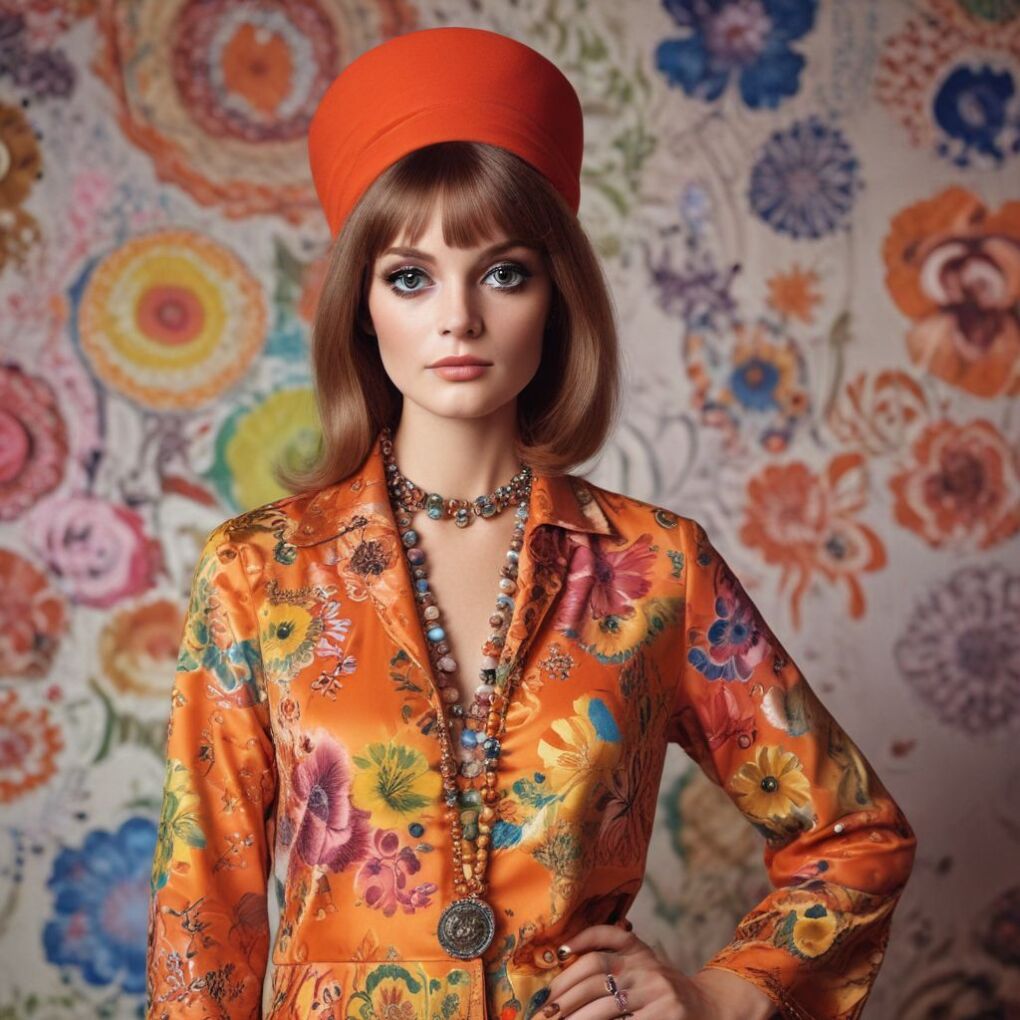
| Icon | Style | Signature Item |
|---|---|---|
| Twiggy | Mod, miniskirts | False eyelashes by Revlon |
| Jean Shrimpton | High fashion model | The “Souper Dress” |
| Brigitte Bardot | Sex symbol | Bardot neckline tops |
| Edie Sedgwick | Andy Warhol’s muse | Statement earrings |
| Jane Birkin | Natural beauty | Denim from Serge Gainsbourg |
| Mia Farrow | Pixie cut | Baby doll dresses by Biba |
| Cher | Hippie glam | Bob Mackie gowns |
| Sharon Tate | Boho chic | Christian Dior minis |
Men’s Fashion in the Late 60s
Men’s fashion also saw significant changes in the late 60s:
- Nehru jackets (popularized by The Beatles)
- Paisley and floral prints (like those from Liberty London)
- Turtlenecks (St. Croix was a popular brand)
- Wide ties (often by Countess Mara or Emilio Pucci)
- Flared pants (from Levi’s or Lee)
- Long hair and beards
Musicians like Jimi Hendrix and Jim Morrison popularized a more flamboyant style, with velvet suits, silk scarves, and open shirts. Meanwhile, the Black Panther Party made black leather jackets and berets powerful symbols of activism.
Key Men’s Brands:
- Carnaby Street’s Lord John – Outfitted The Beatles and The Who
- Mr. Fish – Known for his “man dresses” worn by Mick Jagger
- Wrangler – Their slogan: “Wrangler Jeans… Worn by the world’s toughest cowboys”
- Nik Nik – Famous for their silky, printed shirts
Accessories and Beauty
No discussion of 60s fashion would be complete without mentioning the decade’s distinctive accessories and beauty trends:
Accessories:
- Oversized sunglasses (Foster Grant was huge)
- Chunky plastic jewelry (especially by Kenneth Jay Lane)
- Headbands (including Native American-inspired beaded ones)
- Go-go boots (often by Courrèges or Mary Quant)
- Color-coordinated handbags and shoes
- Mondrian-inspired color-block bags
Beauty:
- Heavy eyeliner – “Doe-eye” look (Elizabeth Arden’s “Smoke and Whispers” set)
- False eyelashes (Twiggy’s were by Revlon)
- Pale lips (like Yardley’s “Slimlick”)
- Big hair – bouffants, beehives (thanks to Aqua Net hairspray)
- Bright eyeshadow (Mary Quant’s paint box palettes)
- Youthful scents (like Love’s Baby Soft)
Vidal Sassoon revolutionized hairstyling with his geometric, easy-to-maintain cuts. His most famous creation was the asymmetric five-point bob, worn by style icon Mary Quant.
Pro Tip: For authentic 60s makeup, it’s all about the eyes. Apply heavy black eyeliner, piling it on the upper lid and in the crease. Add a pop of bright eyeshadow, like turquoise or lime green, and finish with lots of mascara or false lashes.
The Politics of 60s Fashion
Fashion in the 60s was more than just clothing—it was a form of political expression:
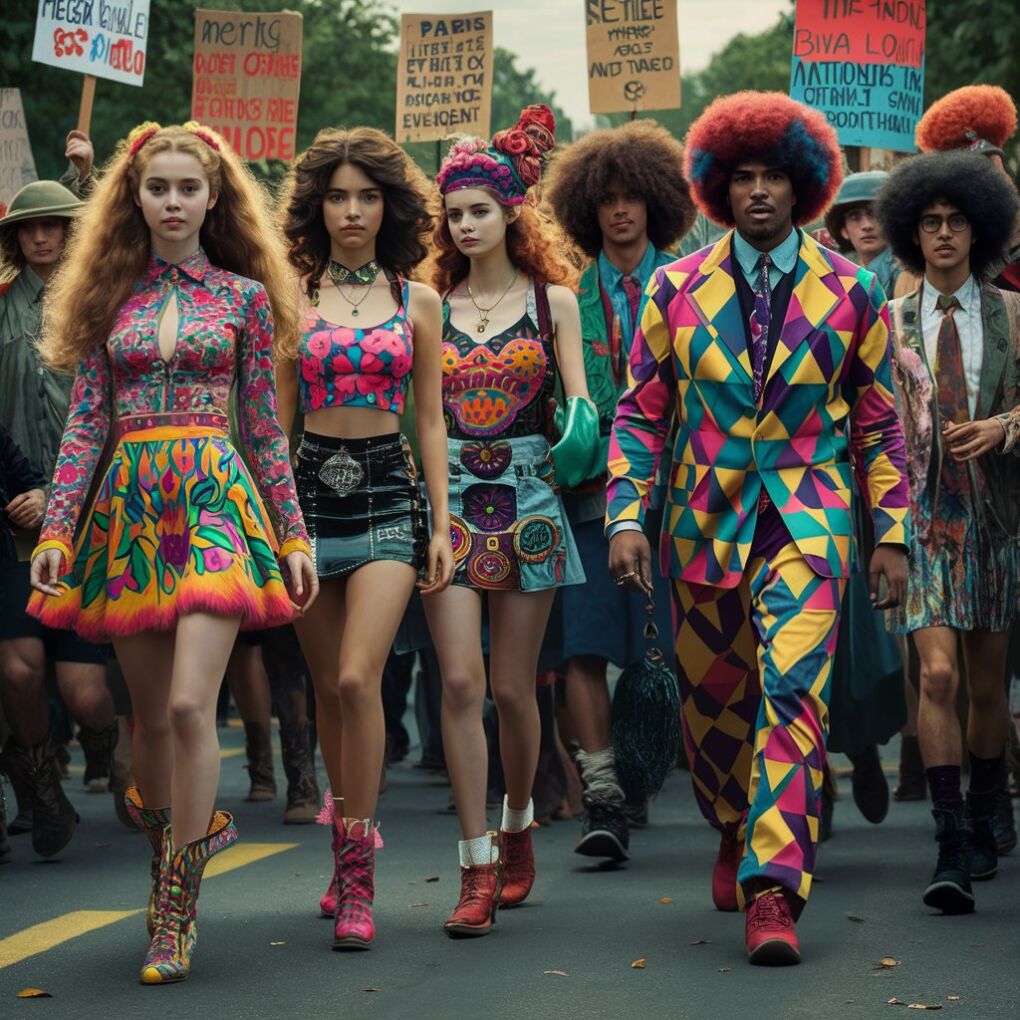
- Miniskirts symbolized women’s liberation.
- Long hair on men signified rebellion against conformity.
- Black turtlenecks (often from J. Crew) were associated with beatnik intellectuals.
- The Black Panther Party used style to express pride and solidarity.
- Anti-war patches and badges (often homemade) on denim jackets.
“Fashion is not something that exists in dresses only. Fashion is in the sky, in the street. Fashion has to do with ideas, the way we live, what is happening.” – Coco Chanel
Political Fashion Items:
- Wool Beret – Symbol of revolutionaries, from Black Panthers to Che Guevara.
- Peace Sign Jewelry – Often handcrafted or by boutique designers.
- Military Surplus Jackets – Worn ironically by anti-war protesters.
- “Make Love Not War” T-Shirts – A DIY staple.
Pro Tip: To make a political statement 60s-style, subtlety is not the goal. Wear your beliefs boldly, whether it’s a giant peace sign necklace or a hand-painted jacket. The 60s were about making your voice—and your fashion—heard.
Conclusion: The Legacy of 60s Fashion
The 1960s was a transformative decade for fashion, mirroring the era’s social and cultural upheavals. From the elegant styles of the early years to the bold, rule-breaking looks of the late 60s, fashion became a canvas for expressing new ideas and identities.
Sixty years on, the influence of 60s fashion is still powerfully felt. Its iconic styles—miniskirts, bell-bottoms, go-go boots—continue to cycle in and out of vogue. More profoundly, its spirit of using fashion as a tool for personal and political expression remains relevant in an age where what we wear often reflects our values.
The 60s showed us that fashion is more than just clothes; it’s a reflection of our times, a statement of who we are, and sometimes, a glimpse into the future. As we face our own era of change and challenge, the bold, innovative spirit of 60s fashion continues to inspire.
Pro Tip: To truly embrace 60s fashion, don’t just wear the clothes—live the attitude. Whether you’re drawn to the polished elegance of the early 60s or the rebellious spirit of the late 60s, wear your chosen style with confidence. The 60s were about breaking rules and expressing individuality, so make the look your own!
Further Reading
To dive deeper into 60s fashion, consider these resources:
- “Sixties Fashion: From ‘Less is More’ to Youthquake” by Jonathan Walford
- “The World Goes Pop” exhibition at Tate Modern (2015-2016)
- “Mary Quant” retrospective at V&A Museum (2019-2020)
- Fashion History Timeline by FIT
- The Costume Institute at The Metropolitan Museum of Art
- “Ready Steady Go!: The Weekend Starts Here” – Book about the mod scene
- “Hippie Chic” by Lauren D. Whitley – From the Museum of Fine Arts, Boston
- Harper’s Bazaar and Vogue archives from the 1960s
